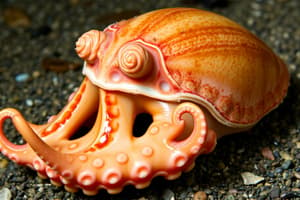Podcast
Questions and Answers
What is the phylum of squid?
What is the phylum of squid?
- Arthropoda
- Cnidaria
- Mollusca (correct)
- Annelida
What is the class of squid?
What is the class of squid?
- Polyplacophora
- Cephalopoda (correct)
- Bivalvia
- Gastropoda
What is a siphon in the context of a mollusk?
What is a siphon in the context of a mollusk?
A tubelike structure through which water enters and leaves a mollusk's body.
What are chromatophores?
What are chromatophores?
What is the function of the ink sac in cephalopods?
What is the function of the ink sac in cephalopods?
What are tentacles?
What are tentacles?
What are arms in cephalopods?
What are arms in cephalopods?
What are lateral fins?
What are lateral fins?
What is the mantle in a squid?
What is the mantle in a squid?
What is the function of squids' eyes?
What is the function of squids' eyes?
What are ommochromes?
What are ommochromes?
What is the radula?
What is the radula?
What is the role of testes in squid?
What is the role of testes in squid?
What does the ovary do in squid?
What does the ovary do in squid?
What is the systemic heart in squids?
What is the systemic heart in squids?
What is the primary method of locomotion in a squid?
What is the primary method of locomotion in a squid?
Why can squid change color faster than other organisms?
Why can squid change color faster than other organisms?
What is an example of convergent evolution between squid and higher order animals?
What is an example of convergent evolution between squid and higher order animals?
Study Notes
Phylum: Mollusca / Class: Cephalopoda / Species: Squid
- Squids belong to the phylum Mollusca and class Cephalopoda.
- Their body plan includes distinct features such as tentacles, arms, and fins.
Anatomy and Physiology
- Siphon: A tube structure for water entry and exit, aiding in locomotion.
- Chromatophores: Pigment cells that enable color changes in response to environmental stimuli.
- Ink Sac: An organ that produces ink for defense against predators.
- Tentacles: Long, flexible structures used for capturing prey.
- Arms: Eight shorter appendages that assist in manipulating prey and swimming.
- Lateral Fins: Muscular structures providing propulsion and maneuverability without bony support.
- Mantle: Protective layer enveloping the visceral mass, crucial for water propulsion.
- Eyes: Highly developed organs capable of forming images and detecting light.
Reproductive Organs
- Hectocotylus: A modified arm in males for transferring sperm to females.
- Testes: Organs responsible for sperm production.
- Spermatophoric Gland: Facilitates the production of sperm cells.
- Ovary: Organ that transfers eggs to the uterus.
- Oviduct: Connects the ovary with the uterus for egg passage.
- Nidamental Gland: A gland involved in secreting eggs or gelatinous egg masses.
Digestive System
- Stomach: Oval structure functioning in digestion, adjacent to the caecum.
- Cecum: The start of the large intestine, enhancing digestive surface area.
Circulatory System
- Systemic Heart: Pumps oxygenated blood received from gill hearts to the squid's body.
- Branchial Hearts: Smaller chambers that pump deoxygenated blood to the gills for oxygenation.
Respiratory System
- Gills: Respiration organs, feathery in structure, facilitating gas exchange.
Locomotion and Behavior
- Jet Propulsion: Squids use jet propulsion by filling their mantle cavity with water and expelling it via the siphon for movement.
- Color Change Mechanism: Chromatophores expand and contract through muscle action, allowing rapid color changes for communication and camouflage.
Evolutionary Note
- Convergent Evolution: The camera eye of squid has evolved similarly to those found in higher-order animals, showcasing an example of independent evolution of complex traits.
Studying That Suits You
Use AI to generate personalized quizzes and flashcards to suit your learning preferences.
Description
This quiz includes flashcards focused on the Phylum Mollusca, Class Cephalopoda, and the species Squid. Each card presents key terms and definitions such as siphon and chromatophores, essential for understanding cephalopod biology. Ideal for students looking to enhance their knowledge of marine biology and mollusks.




